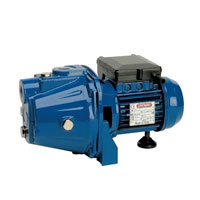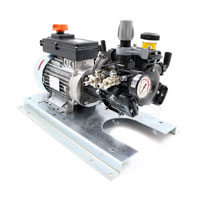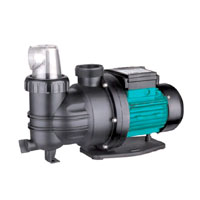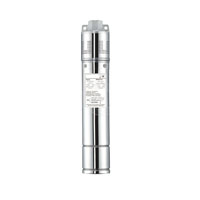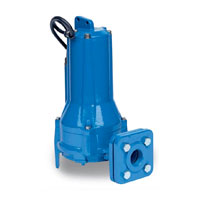Electric Pumps and Engine Pumps: Buying Guide
If you're looking for an electric pump for pressure tanks or an engine pump for irrigating vegetable gardens and lawns, or even pumps for drainage, spraying, pools and emergencies, you're in the right place! Use our filter system for advanced search of electric pumps or engine pumps with combustion engines that best suit your needs. If you're still unsure how to choose the right pump or engine pump for your specific use, keep reading to clarify any doubts.
How much water and power do I need?
When starting your search for an electric pump or engine pump, whether for domestic water supply in homes, for irrigating gardens and vegetable plots, or for agricultural spraying, the first questions to ask are: how much water do I need? how much power do I need?
Answering these questions isn't simple, as hydraulic systems involve multiple variables that change case by case. For example, in a house or apartment building with 3 kitchens and 6 bathrooms, you'll obviously need greater flow rate than a home with 1 kitchen and 1 bathroom.
To precisely determine the most suitable pump or engine pump, beyond the power source (electric or combustion engine), the main specifications to identify are the pump's flow rate and head.

What is a Pump's Flow Rate
Flow rate indicates the volume of water moved in a specific time period. This value is typically expressed in Liters per Minute (l/min) or Cubic Meters per Hour (m³/h).
1 m³/h = 16.67 l/min
To correctly determine the flow rate needed for your water system, you must know how many faucets might be open simultaneously and sum their flow rates to get the total required flow.
For traditional domestic systems, consider these values:
Kitchen + bathroom = 1.7 m³/h
Kitchen + bathroom + toilet = 1.8 m³/h
Kitchen + 2 bathrooms = 2m³/h
Kitchen + 3 bathrooms = 2.2 m³/h
For garden sprinklers, refer to the irrigation area:
for 100 m² = 0.75 m³/h
for 200 m² = 1.5 m³/h
for 300 m² = 2.25 m³/h
for 400 m² = 3 m³/h
For example, to determine the required water flow rate for a home with 1 kitchen and 2 bathrooms plus 200m² garden:
1 KITCHEN + 2 BATHROOMS + 200 m² = 2 m³/h + 1.5 m³/h = 3.5 m³/h = 50 liters/min
Now that we know our system's required flow rate, we can move to the second fundamental parameter for choosing the most suitable pump.

What is a Pump's Head
Head is the elevation difference (measured in meters) between the water level being suctioned by the pump and the pumped water level. The diagram below clearly explains what head means.

Now that we've clarified the meaning of flow rate and head, we can read the pump's technical sheet where we'll find performance curves indicating the pump's actual performance. Here's an example:

To use a pump optimally, it's highly recommended to maintain the head-to-flow rate ratio at the center of the diagram.
Centrifugal and Positive Displacement Pumps: What's the Difference?
Centrifugal pumps are the most widespread across various sectors, with extensive industrial and civil applications due to their characteristics, including:
- simple construction allowing use of various materials like PPO, Noryl, stainless steel etc.
- deliver constant flow and can operate at high rotational speeds, reducing size;
- can transport liquids containing suspended solids;
- achieve maximum efficiency only within a limited range of their performance curve;
- can operate without damage even with discharge valve closed;
- best price-quality ratio
However, centrifugal pumps aren't suitable for transporting highly viscous liquids, and this is where positive displacement pumps come into play. There are various types of positive displacement pumps, each with different properties - some guarantee higher pressures at equal power, others greater flow rates. Some types are better suited for handling large solid particles, others for aggressive fluids, etc.


Now that you have the basics to evaluate which pump suits your needs, use the filter system at the top of the page or browse through the categories below to choose from over 200 catalog models. If you still have doubts, don't hesitate to contact us - our pump and engine pump experts will help you make the right choice!
Best Sellers

Annovi Reverberi ARUP 1100XD
Self-Priming Pump
275 L/min - Head 10.5 m
Ø 1" - 1" 1/4

Leo XST
Flanged Monobloc Centrifugal Electric Pump
1200 L/min - Head 72 m
Ø 1"÷1" 1/2 - 1" 1/2÷2" 1/4

Leo EVP
Multistage Vertical Pump
150 L/min - Head 105 m
Ø G1" ÷ G1" 1/2

Speroni CAM / CA 152
Self-priming electric pump for irrigation
150 L/min - Head 45 m
Ø 1" 1/4 - 1"

Leo LSW
Submersible Drainage Pump
with Grinder
250÷500 L/min - Head 13÷17 m
Ø G2

Leo ACm / AC 2
Single Impeller Centrifugal Electric Pump
500 L/min - Head 22 m
Ø 2" - 2"

GENMAC G1
Motopump Benzian 3 Hp
2.8 bar 133 Liter
133 L/min - Head 28 m
Ø 1" - 1"


Hyundai 35605
7 HP Petrol Motor Pump
8 bar
317 L/min - Prevalenza 80 m
Ø 2" - 2"

Annovi Reverberi ARGP 1100XB
Pump With Autoclave
76 L/min - Prevalence 45 m
Ø 1'' - 1''


Hyundai 35601
2 Inch Self Priming 4 Stroke Motor Pump
333 L/min - Prevalenza 28 m
Ø 2"

